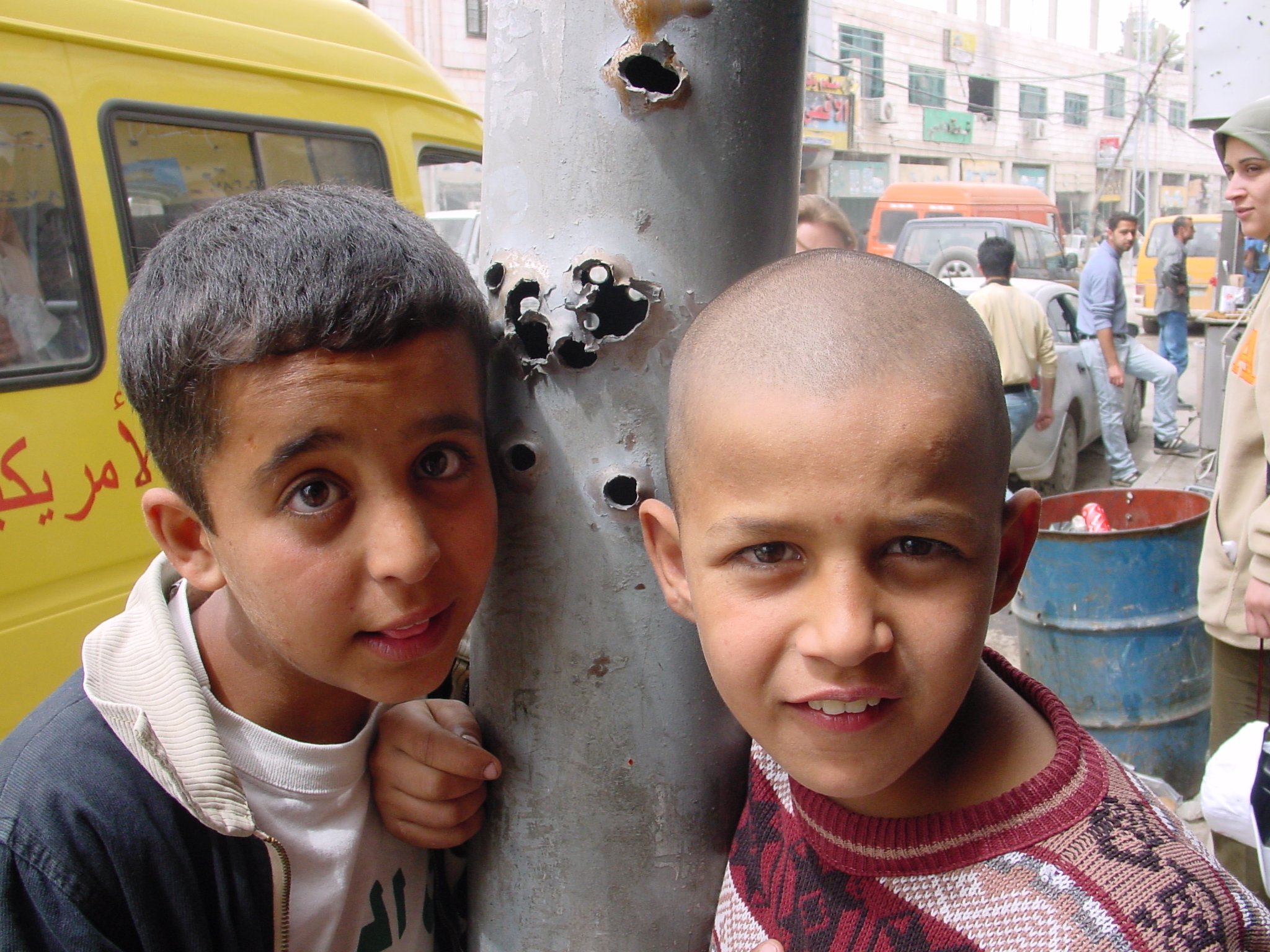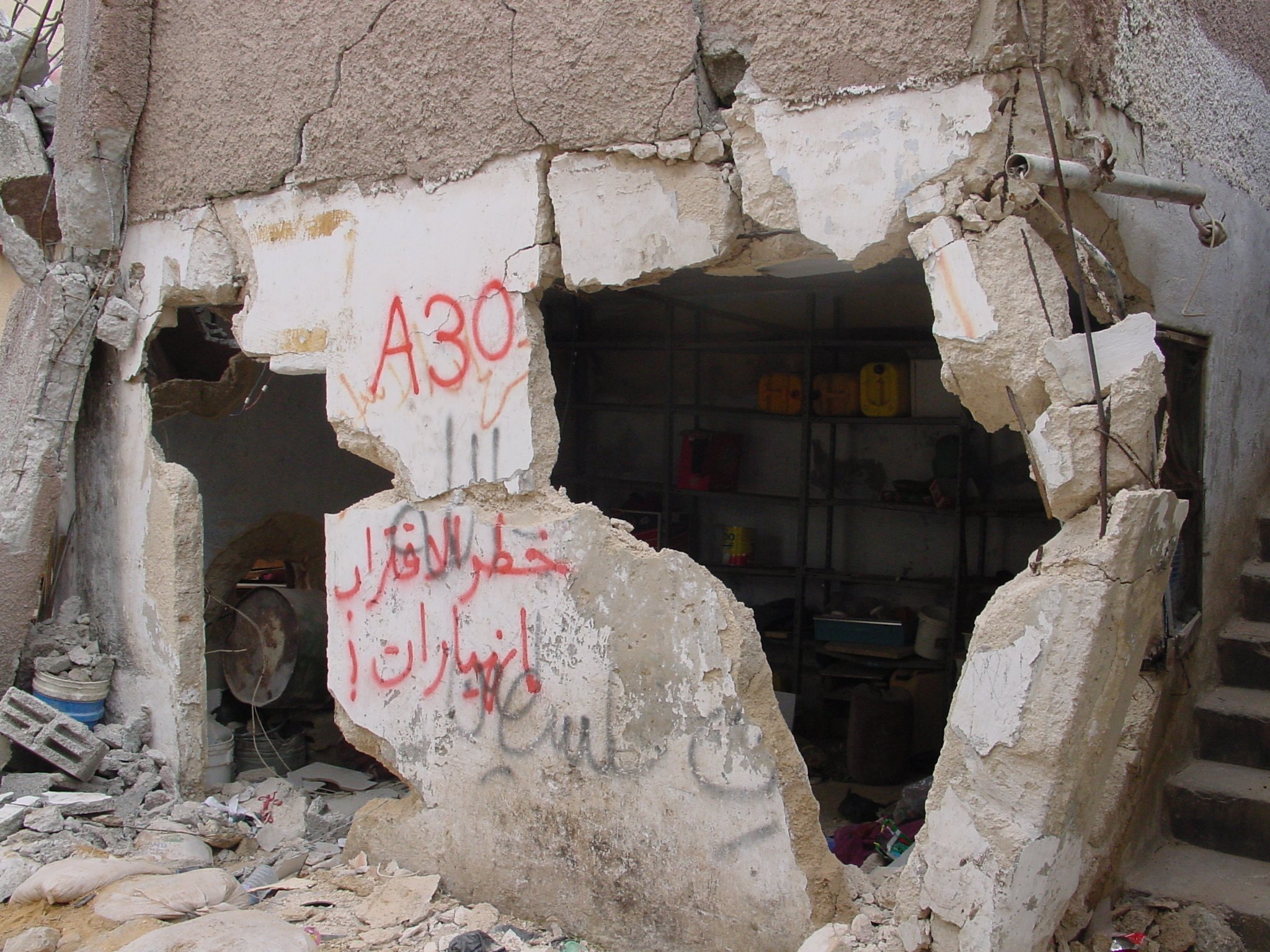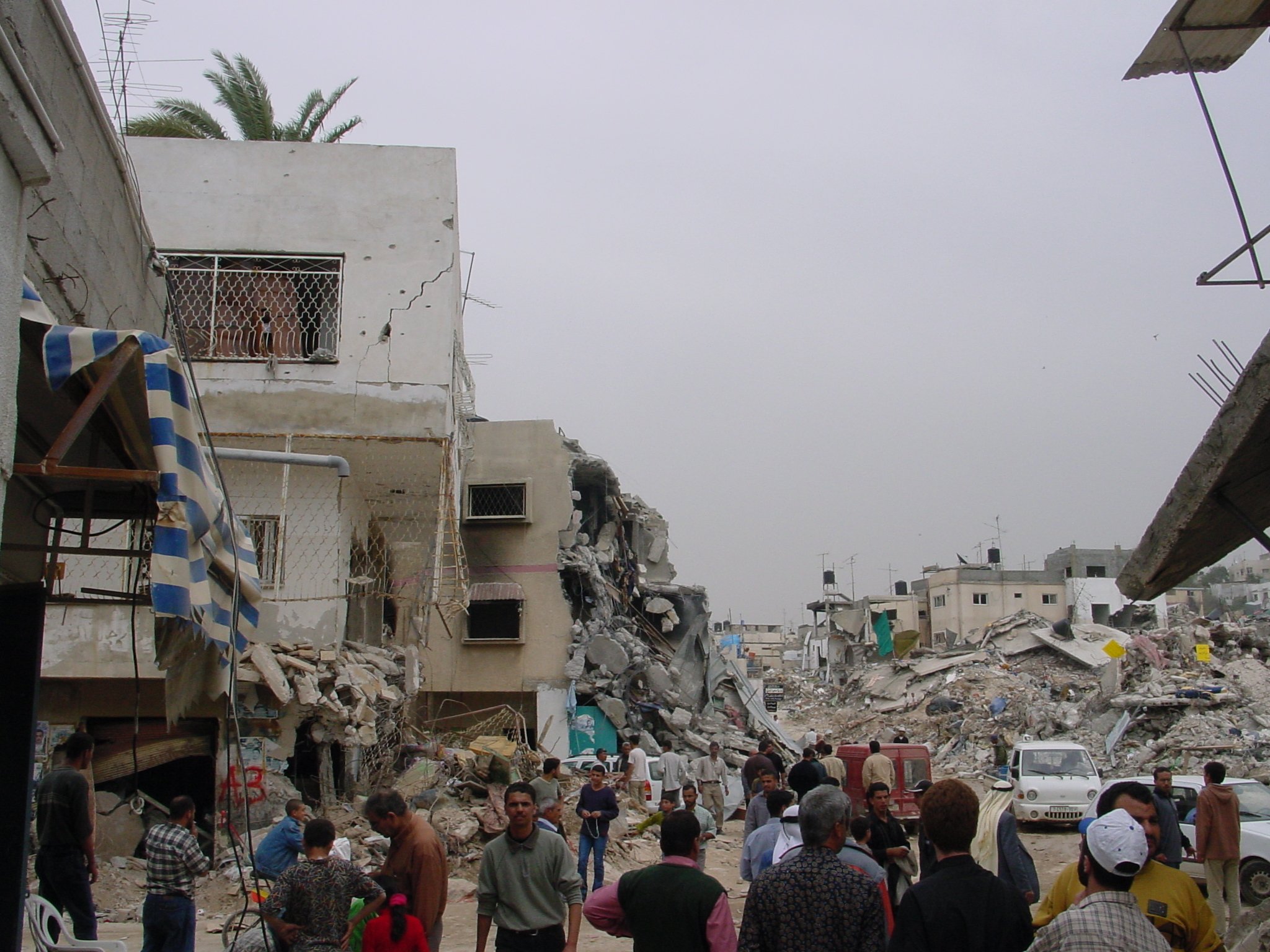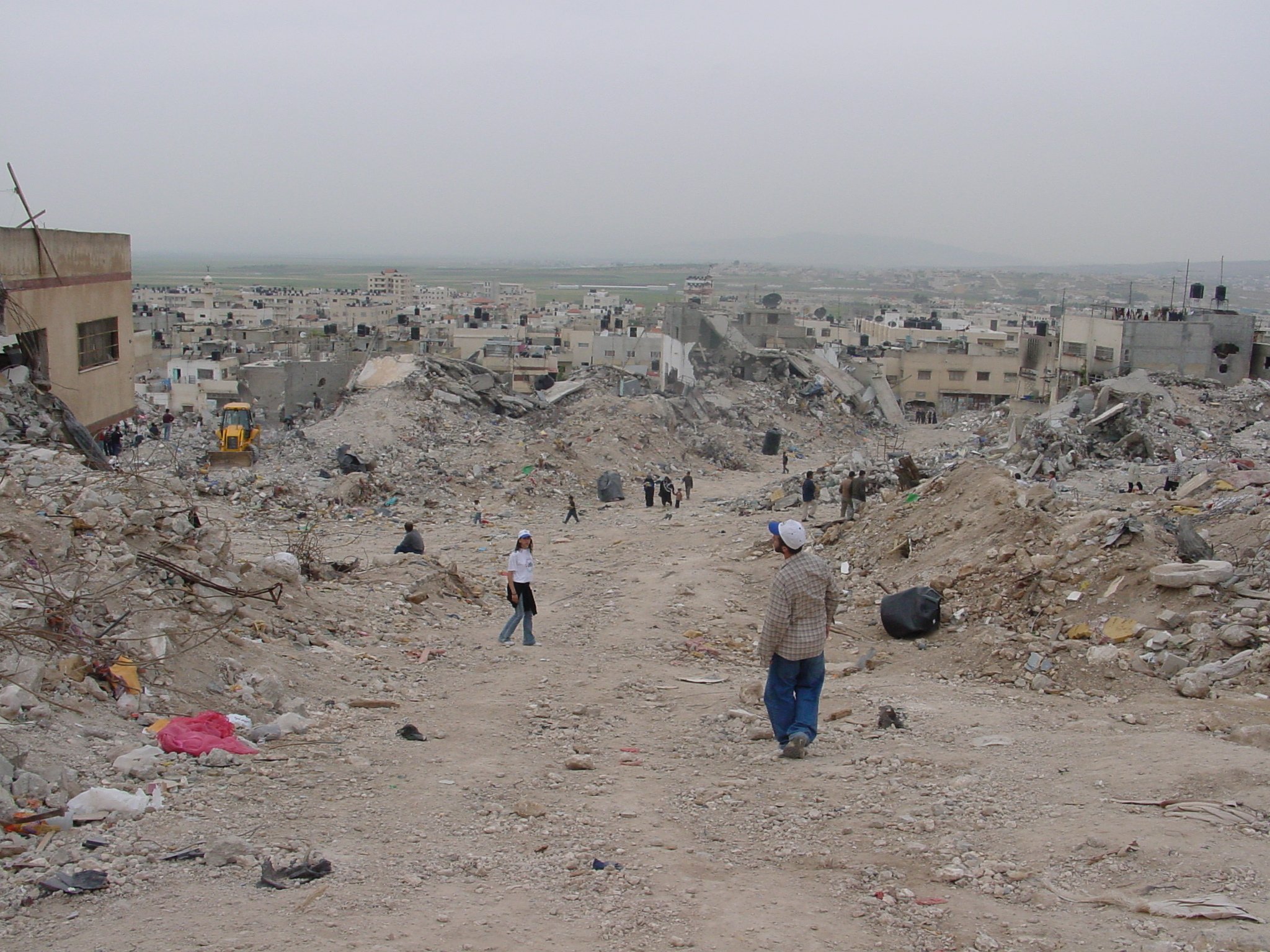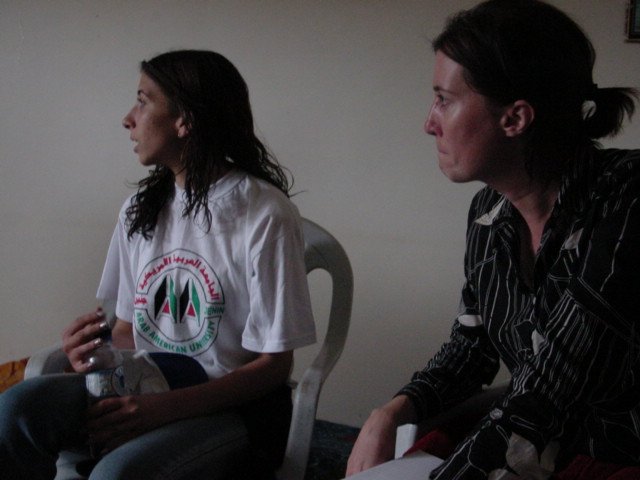April 24, 2002
Early in the morning, we headed home. We had the rental car packed (and loaded down) with supplies (rice, corn oil, flour, baby formula, etc.) for Zababdeh and headed towards the Jalame checkpoint. The number of soldiers hanging around and loading tanks onto huge flatbed trucks gives some credence to the "pull-out" - at least in this area. We spoke with one of the soldiers, who was quite friendly and helpful, and after a bit of bureacracy (and after we explained that the rental car would stay at the checkpoint - our rental agent would have a heart attack otherwise), we passed.
We arrived via taxi to Zababdeh in time to unload the food and goods at the Latin Convent just before school let out. School has returned, but not at full schedule - in the abbreviated school day, students have been studying the "foundation" courses (English, Arabic, sciences, math).
Two Palestinian boys pose by a bullet-riddled utility pole in downtown Jenin.
A damaged building hastily scrawled with “danger” in Arabic.
Entering into Jenin Camp’s “Ground Zero” with its rampant destruction.
We spoke with one of our friends at the Arab-American University of Jenin who was coordinating student volunteer work within Jenin Camp and invited us along. We met up with them in Jenin itself, which looks like the Camp did a month ago. Every building along the roads near the Camp is pock-marked with bullet holes. Lamp stands and electricity poles are hunched over at 90 degree angles. We actually saw a few policemen (quite a shock), but they weren't carrying guns anymore - only batons. "See how civilized we've become?" quiped a friend. "Just like British Constables." The air was thick with dust, most of it coming from the direction of the Camp. We arrived there soon after. As much as we've seen on TV and in newspapers, nothing really prepared us for the panorama of destruction.
Walking through the rubble of what was once a densely-populated area of Jenin Camp.
A family looking through what remains of their home in Jenin Camp.
Jenin Camp’s “Ground Zero”, with dozens of homes reduced to nothing more than rubble.
The view of Jenin Camp’s destruction from the mosque, with the greenery of the Galilee in the background.
We walked up what once had been narrow roads, where street-level homes and businesses were smashed open to make room for tanks. People were picking through rubble, and we saw journalists and Palestinian Red Crescent/Red Cross workers here and there. There was a moment, though, when we turned a corner and entered the center of the wreckage. People have described it as a "moonscape", or a very severe earthquake aftermath. Some are calling it "Jenin Ground Zero" - the scene reminded us of images following the World Trade Center attack. Nothing but crumbling buildings and rubble, cloaked in an other-worldly haze of smoke and dust. A handful of bulldozers were moving about, scraping away. "Danger" is scrawled in Arabic across buildings. Every now and then we heard the sound of rubble falling.
People were sitting in the second stories of half-destroyed buildings that surround the central area, sipping on tea and surveying the destruction. Here and there you see something in the rubble that has not been totally destroyed - a baby's chair, a section of furniture, a piece of a garment. There is a hushed awe about this place. Rarely do you find silence in Arab society, but here in this gaping wound is silence.
We watched for a while as medical volunteers and family members, wearing latex gloves and face masks, dug at a pile of rubble with shovels and their hands. Before we arrived, some of the University students told us, a torso and a leg had been found. We saw the white plastic bodybag, and waited a bit. Before long, a decomposing hand (or so we were told - it looked like a maroonish lump to us) was added to the bag.
The students from the University have offered their services in whatever ways they might be helpful. Their biggest duty right now is acting as translators for aid workers and foreign journalists. We joined one group of students and a journalist as they spoke with a 15 year-old girl. She has been keeping a diary since the beginning of the Intifada, the makings of an intriguing story. When asked if she wrote about her feelings, she said no, she only wrote the facts - from TV, radio, and her window. Numbness might be the safest reaction to this place. Her family was kept in one room for a week - twenty-four of them - while soldiers took over their house to shoot at the rest of the camp. When anyone had to use the bathroom, they knocked on the door and asked the soldiers for permission. For meals, one woman was allowed to go to the kitchen and prepare food. The rest of the time, night and day, they were crowded together, hearing the sounds of the war outside and the soldiers in their home. The girl's father spoke about that first moment of stepping outside, after the siege was lifted, and feeling like they were alive again, like a new birth. And then he said that feeling dissipated into horror as they realized the extent of the devastation.
We continued up to the mosque, which the Israeli army used as an outpost. From there, we got a fuller vision of what it looked like below. Ironically, we could see verdant farm fields in the distance, stretching out past the Green Line and on into the relative normalcy of Israel itself. Anger bubbles up, as does sadness and overpowering grief - for for what is known, what will be known, and what may never be known about what happened here.
Student volunteers from the nearby Arab-American University are helping people share their stories with international journalists.
We returned home in time to hear an Israeli spokesman on TV summarize what happened in Jenin as a "fierce gun battle." The lies around here are thicker than the dust that emanates from "Ground Zero".

